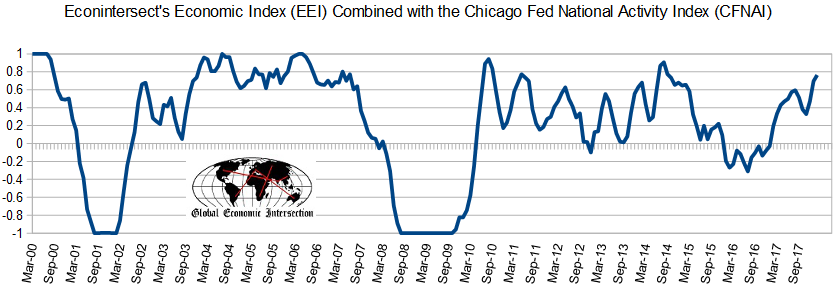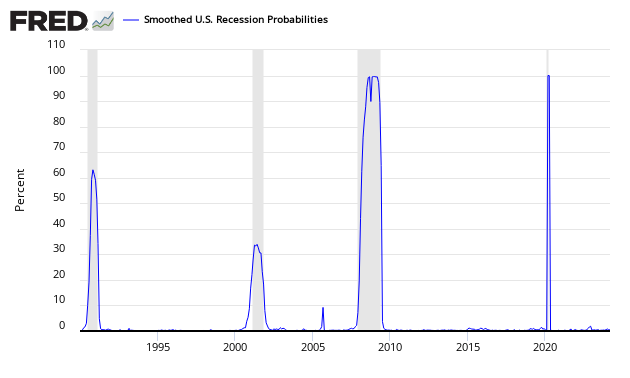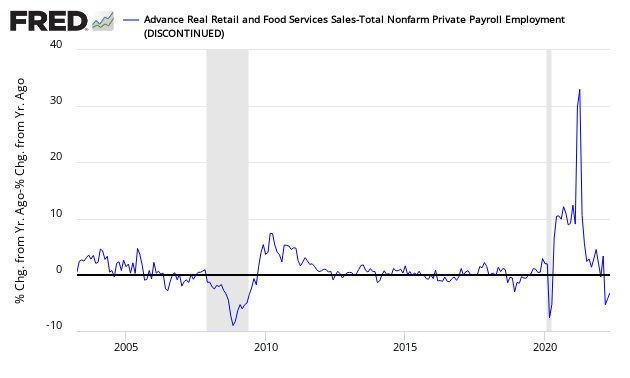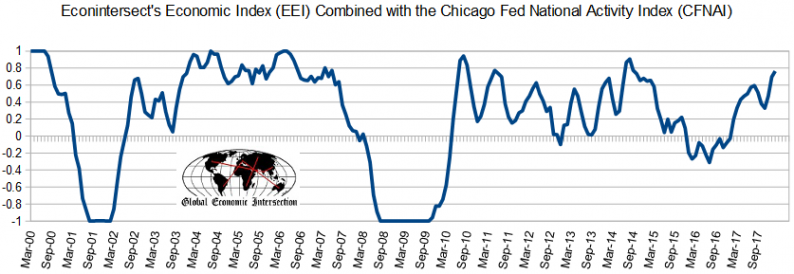Econintersect’s Economic Index (EEI) declined and returned to territory associated with modest economic growth.
Analyst Summary of this Economic Forecast
Ok – what happened this month? Basically the most recent hard data we use to create the EEI had a trend change (better to worse) – even though the downward trends were modest. If I take the most recent data included in the Chicago Fed National Activity Index (CFNAI) and add its data to the data sets we use to create this index – our index would have improved. Note that:

The problem with the CFNAI is that it is subject to backward revision which too many times have changed its trends. While it is possible that the EEI is incorrect in forecasting a slowing trend, the size of the slowing is significant (using the one month index and not the three month rolling average). This should raise doubts that the CFNAI’s trends are correct.
Even though not in our forecast, we remain concerned about the HISTORICALLY HIGH elevated spending to income ratios which paints a picture of a consumer spending all of its income – with little room for additional spending or ability to weather rainy days (or say hurricanes and earthquakes). Note that the quantitative analysis which builds our model of the economy does not include personal income or expenditures data sets.
Another data point – the relationship between retail sales and employment declined but remains in firmly in positive territory. Historically, when this ratio is in negative territory it indicates a slowing economy. Note that neither employment nor retail sales are part of our economic model.
Econintersect checks its forecast using several alternate monetary based methods – and the checked forecasts show economic growth.
Our 6-month employment forecast indicates little change in the rate of employment growth.
Note that the majority of the graphics in this post auto-update. The words are fixed on the day of publishing, and therefore you might note a conflict between the words and the graphs due to new data and / or backward data revisions and/or new data.
This index is not designed to guess GDP – or the four horsemen used by the NBER to identify recessions (industrial production, business sales, employment and personal income). It is designed to look at the economy at the Main Street level.
The graph below plots GDP (which has a bias to the average – not median – sectors) against the Econintersect Economic Index.

This post will summarize the:
Special Indicators:
The consumer is still consuming. The ratio of spending to income has been very elevated since September 2016. There have been only three extended periods in history where the ratio of spending to income has exceeded 0.92 (the months surrounding the 2001 recession, from September 2004 to the beginning of the 2007 Great Recession, and since September 2016).
Seasonally Adjusted Spending’s Ratio to Income (an increasing ratio means Consumer is spending more of Income)

The St. Louis Fed produces a Smoothed U.S. Recession Probabilities Chart which is currently giving no indication of an oncoming recession.
Smoothed recession probabilities for the United States are obtained from a dynamic-factor markov-switching model applied to four monthly coincident variables: non-farm payroll employment, the index of industrial production, real personal income excluding transfer payments, and real manufacturing and trade sales. This model was originally developed in Chauvet, M., “An Economic Characterization of Business Cycle Dynamics with Factor Structure and Regime Switching,” International Economic Review, 1998, 39, 969-996. (http://faculty.ucr.edu/~chauvet/ier.pdf)

Econintersect reviews the relationship between the year-over-year growth rate of non-farm private employment and the year-over-year real growth rate of retail sales. This index is now significantly positive. When retail sales grow faster than the rate of employment gains (above zero on the below graph) – a recession is not imminent. However, this index has many false alarms.
Growth Relationship Between Retail Sales and Non-Farm Private Employment – Above zero suggests economic expansion

GDPNow
The growth rate of real gross domestic product (GDP) is the headline view of economic activity, but the official estimate is released with a delay. Atlanta’s Fed GDPNow forecasting model provides a “nowcast” of the official estimate prior to its release. Econintersect does not believe GDP is a good tool to view what is happening at Main Street level – but there are correlations.
Latest forecast: 4.2 percent — January 29, 2018
The initial GDPNow model forecast for real GDP growth (seasonally adjusted annual rate) in the first quarter of 2018 is 4.2 percent on January 29. The advance estimate of fourth-quarter real GDP growth released by the U.S. Bureau of Economic Analysis on January 26 was 2.6 percent, 0.8 percentage points below the final GDPNow model nowcast released on the previous day.













Leave A Comment